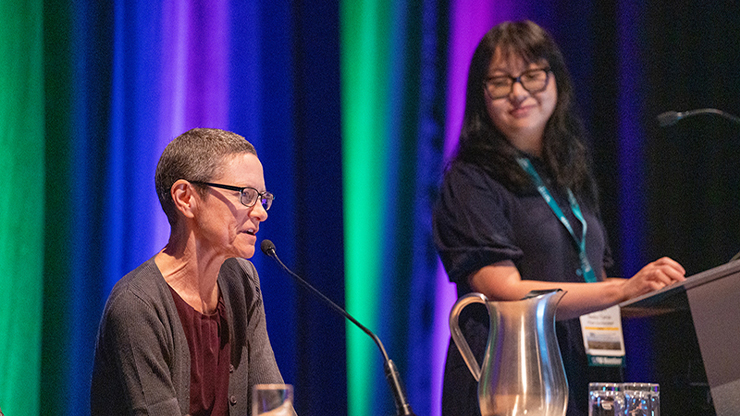Navigating Challenges, Opportunities, and Uncertainties as Women in Data Science
Data science is an exciting area of study that presents opportunities for researchers to apply computational, mathematical, and domain-specific knowledge to a diverse array of problems. Yet despite the field’s continued growth and broad applications, the gender distribution among data scientists remains imbalanced; according to Women in Data Science Worldwide, females comprise less than 20 percent of data science students and under 10 percent of decision-makers in the field. As such, women who pursue careers in data science may encounter gender biases or roadblocks that pertain to professional development; mentorship; and the balance between work, life, and family.
During the Third Joint SIAM/CAIMS Annual Meetings (AN25)—which took place in Montréal, Québec, Canada, this past summer—the Association for Women in Mathematics hosted an engaging panel session that focused on the experiences of women in data science professions. The event was co-organized by Jamie Haddock of Harvey Mudd College and Anna Little of the University of Utah. Little chaired the discussion between panelists Tammy Kolda of MathSci.ai, Anna Konstorum of the Institute for Defense Analyses, and Yifei Lou and Caroline Moosmueller of the University of North Carolina at Chapel Hill, all of whom shared insights into the realities of data science careers.
The panelists opened the conversation by outlining their processes for beginning new data science projects and identifying worthwhile research problems. “My advice for choosing problems, especially in the early stages of your career, is to read deeply and broadly,” Kolda said, recommending survey papers and foundational book series as good sources of information. She explained that early-career researchers who develop a formative knowledge base can better understand the field and start to formalize their own questions. “Aim for something that doesn’t just make [a problem] a little bit better, but takes it from unsolvable to solvable,” Kolda continued. “Don’t just aim for papers; aim for solving problems that are interesting to you.”

Working with collaborators in interdisciplinary fields can introduce junior scientists to a wide range of open problems. For example, Konstorum has stumbled upon interesting research questions by helping colleagues with a nonfunctioning algorithm, then digging deeply into the issue’s underlying cause. “If you’re hitting a wall, be open to going ‘if I can find a way to get through that, that’s research,’” she said. However, it is equally necessary to prepare for the inevitable reality that some research endeavors may not be successful. “It’s just something that you have to get used to,” Moosmueller said. “Not every idea and great collaboration will lead to a paper.”
The panelists next discussed their respective experiences with mentorship, which can play a major role in data science career trajectories. Lou reported that she has especially benefited from the mentorship of senior coworkers who divulged useful tips and tricks for working within specific academic settings. Kolda then elaborated on the idea of sponsorship, wherein a mentor works diligently behind the scenes to support a junior colleague’s progression. By attending scientific gatherings early in her career and being bold and strategic in her interactions, Kolda was able to establish connections with potential sponsors. On the other hand, Moosmueller admitted that she has not had many mentors and reassured listeners that success is still possible even without effectual mentorship. Instead, she has benefited from a robust network of both veteran researchers and peers whose experience levels mirror her own.
As in many scientific careers, data scientists may face time management challenges and competing demands from work, research, teaching, travel, and service. Although Lou emphasized that it is okay to say “no” to certain appeals, particular strategies for tactfully saying “no” can help avoid negative consequences. For internal requests, one can politely list current responsibilities and inquire how to best adjust them to accommodate a new task. However, external requests may require more delicate handling and additional flattery; and when feasible, saying “yes” to these asks can lead to important visibility and connections.
Konstorum advised female listeners to confirm that the demands on their time are indeed appropriate, especially in terms of nonscientific departmental services. “Be your own advocate,” she said, urging attendees to assess whether their male counterparts are fielding the same types of requests. “Be aware of what’s going on and talk to your colleagues.”
When the workload does require multitasking, the panelists offered several suggestions to tackle competing demands. “Make a list and cross it off,” Lou said. “Sometimes, add a deadline.” Effective tactics can involve comparing notes with colleagues who have similar workloads, occasionally switching the subject of focus to keep things fresh, and actively defining a set schedule. “As time goes on, you learn how to do it,” Moosmueller said. “Somehow you adapt; sometimes it’s easier and sometimes it’s harder.”
Data scientists—especially those in the early stages of their careers—may experience burnout for several reasons, including high workloads or psychological barriers like lack of advisor support, research obstacles, or concerns about future employability. “The first step is to identify the sources,” Konstorum said. “If you’re not feeling motivated and you don’t have a ton of work, sit down with yourself and figure out what’s going on.” Select strategies can help individuals push through the loss of motivation and avoid diminishing returns when they are overloaded or uninspired. For instance, maintaining hobbies and passions outside of research can prevent overwork and provide a creative or physical outlet. It can also be helpful to recognize the cyclical nature of academic work in particular, with varying time requirements for teaching, writing grants, and conducting research throughout the year.
In addition to burnout, data scientists at all career levels might experience the isolating effects of imposter syndrome, where an individual feels as though they do not belong in a certain environment or were not “built for research.” The panelists disclosed that even they still encounter these feelings on occasion. Kolda is a proponent of “faking it until you make it;” she noted that she likes to imagine herself in the mindset of a different, more outspoken person. Konstorum, who majored in biology as an undergraduate, then recalled that she felt like an imposter when starting her Ph.D. studies in mathematics. But as she began to find success in her research, she realized that she possessed a unique skillset and viewpoint that others in her cohort did not. “If you feel like an imposter, that means you have something different than the people there and something unique to add,” Konstorum said.

The panelists agreed that it is best to avoid comparing oneself with other scientists who may have a greater number of citations or a more developed research profile. Mental health resources can help researchers cultivate the focus and self-control that is required to avoid unhealthy behaviors, such as overly checking Google Scholar. It is also important to remember that everyone has different professional and personal responsibilities and priorities; routine self-reflection about one’s own motivations, previous achievements, and future goals is almost always beneficial. “If I was young me, I’d really want to be [current] me,” Kolda said. “You’ll have your own way of being successful.”
Job seekers who also wish to prioritize their families should thoroughly research open positions to determine a department’s level of support for working parents, which may vary between organizations both within and outside of academia. Throughout her career, Lou—who has two children—has found her colleagues to be understanding about any necessary adjustments to her schedule. “Most people try to accommodate my requests,” she said.
For those in the U.S., the political climate imposes additional stress and uncertainty surrounding the stability of research projects, job opportunities, and accessible funding. The panelists stated that they have been leaning on their general life skills—connecting with colleagues, fortifying their networks, thinking creatively to overcome setbacks, and taking opportunities to learn—to offset some of the strain. In the present environment, the job search may also require some extra patience. “You have really good skills, so give yourself some breathing room as things may take a little time,” Kolda said.
When advising students amidst the ongoing uncertainty, Moosmueller acknowledges the reality behind their worries and talks to them about alternative career paths outside of academia. Taking pragmatic action can help students and researchers maintain their forward momentum and confidence during unsteady circumstances. “What you can control is getting up in the morning and doing good research,” Moosmueller said. “This is what we should focus on at the moment.”
Researchers should also find genuine opportunities to affect the culture within their own communities. Institutionally, sitting on hiring committees and encouraging student leadership can shape the culture of a department. “Pass down this goodwill to the next generation,” Lou said. “That’s a big way to make an impact.” On a larger scale, volunteering and accepting leadership roles at organizations like SIAM can influence the direction of an entire field. It is never too early to start building this network and advocating for long-term impacts.
The panelists concluded the AN25 session with some final thoughts for early-career data scientists. Moosmueller and Konstorum urged attendees to remain aware of other people’s points of view when heeding their advice; advisors may not always know the best course of action for a specific situation or goal, so it is important to consult a variety of viewpoints while ultimately forging one’s own path. “Seek out people who will not just tell you what to do, but will listen and help you articulate what you want to do,” Konstorum said.
Kolda emphasized the significance of networking for career progression. Setting goals for conference interactions, perfecting a personal introduction, and following up via email are reliable ways to establish a wide network of people who can assist with various problems and goals. Ultimately, the panelists affirmed that every connection is worthwhile; soon enough, fellow students and early-career researchers will be making a large impact on the field.
About the Author
Jillian Kunze
Master's student, Drexel University
Jillian Kunze is the former associate editor of SIAM News. She is currently a master’s student in data science at Drexel University.

Related Reading
Stay Up-to-Date with Email Alerts
Sign up for our monthly newsletter and emails about other topics of your choosing.






